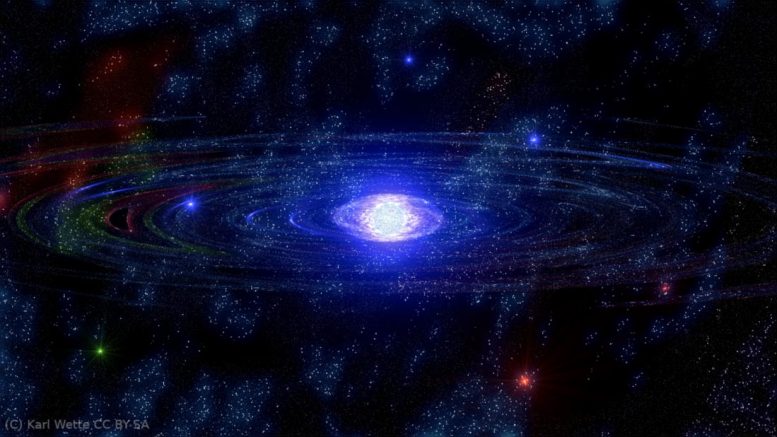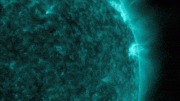Remember the days before working from home? It’s Monday morning, you’re running late to beat the traffic, and you can’t find your car keys. What do you do? You might try moving from room to room, casting your eye over every flat surface, in the hope of spotting the missing keys. Of course, this assumes that they are somewhere in plain sight; if they’re hidden under a newspaper, or fallen behind the sofa, you’ll never spot them. Or you might be so convinced that you last saw the keys in the kitchen and search for them there: inside every cupboard, the microwave, dishwasher, back of the fridge, etc. Of course, if you left them on your bedside table, upending the kitchen is doomed to failure. So, which is the best strategy?
Scientists face a similar conundrum in the hunt for gravitational waves—ripples in the fabric of space and time—from rapidly spinning neutron stars. These stars are the densest objects in the Universe and, provided they’re not perfectly spherical, emit a very faint “hum” of continuous gravitational waves. Hearing this “hum” would allow scientists to peer deep inside a neutron star and discover its secrets, yielding new insights into the most extreme states of matter. However, our very sensitive “ears”—4-kilometer-sized detectors using powerful lasers—haven’t heard anything yet.
Part of the challenge is that, like the missing keys, scientists aren’t sure of the best search strategy. Most previous studies have taken the “room-to-room” approach, trying to find continuous gravitational waves in as many different places as possible. But this means you can only spend a limited amount of time listening for the tell-tale “hum” in any one location—in the same way that you can only spend so long staring at your coffee table, trying to discern a key-shaped object. And since the “hum” is very quiet, there’s a good chance you won’t even hear it.
In a study recently published in Physical Review D, a team of scientists, led by postdoctoral researcher Karl Wette from the ARC Centre of Excellence for Gravitational Wave Discovery (OzGrav) at the Australian National University, tried the “where else could they be but the kitchen?” approach.
Wette explains: “We took an educated guess at a specific location where continuous gravitational waves might be, based in part on what we already know about pulsars—they’re like neutron stars but send out radio waves instead of continuous gravitational waves. We hypothesized that there would be continuous gravitational waves detected near pulsar radio waves.” Just like guessing that your missing keys will probably be close to your handbag or wallet.
Using existing observational data, the team spent a lot of time searching in this location (nearly 6000 days of computer time!) listening carefully for that faint “hum.” They also used graphic processing units—specialist electronics normally used for computer games—making their algorithms run super-fast.
“Our search was significantly more sensitive than any previous search for this location,” says Wette. “Unfortunately, we didn’t hear anything, so our guess was wrong this time. It’s back to the drawing board for now, but we’ll keep listening.”
Reference: “Deep exploration for continuous gravitational waves at 171–172 Hz in LIGO second observing run data” by Karl Wette, Liam Dunn, Patrick Clearwater and Andrew Melatos, 23 March 2021, Physical Review D.
DOI: 10.1103/PhysRevD.103.083020










… can’t stop with entanglement, should there be some way in which we would see some, ….
… yeah, I know the speed of light, but…
…Schrödinger equation…
… the Priest, you know…
… Wormhole…
6 000 / 365 = 16 years !
False theories lead to a waste of time and money. Gravitational waves do not exist because gravity is the reactive thrust of ordinary electromagnetic waves. Didn’t they try to look under your feet? Why do scientists themselves attract, or rather, press to the ground?
My “theory of everything” answers many questions.
https://www.youtube.com/watch?v=tFUM3vAlaGc
The diameter of our universe = 2 * 10 ^ 28 light years. The visible part is 13.8 * 10 ^ 9 years. If there is a neighboring universe of the same age – the distance to its visible stars = (28 – 9) * 2 = 10 ^ 38 light years. You need to search through the super void of Eridanus or another similar edge of the visible part of our universe.
All three types of dark matter exist in each atom:
1) strings, from which quarks are synthesized in the Center of Our Universe
;
2) quarks, from which nucleons were synthesized in black holes;
3) nucleons from which atoms visible to us were synthesized in stars.
Galaxies collide only when a black hole disappears in one of them and the galaxy tangent descends from orbit around the Center of the Universe.
This theory provides answers to all questions about space and the work of scientists for 100 years.
Can required sensitivity be inferred based on the already detected black hole mergers? The detected gravity waves from merger events possibly use to infer a lower background level and then search for lower level (or determine if it can be detected with current instruments).